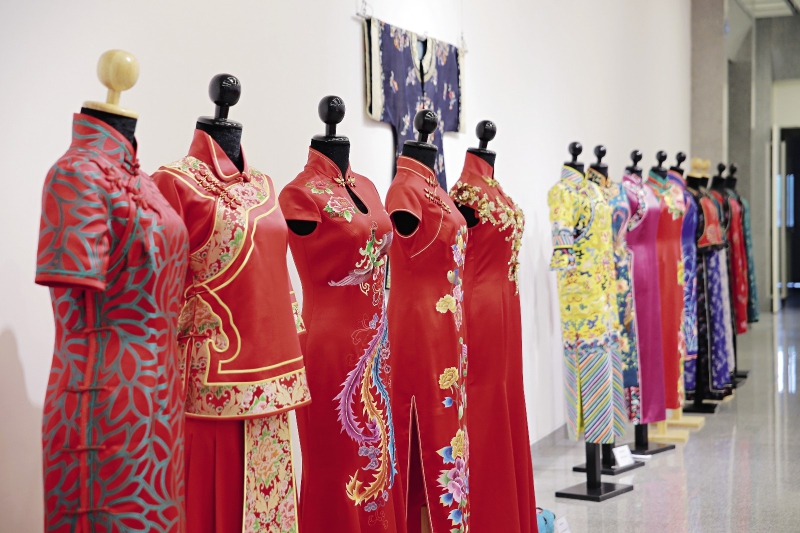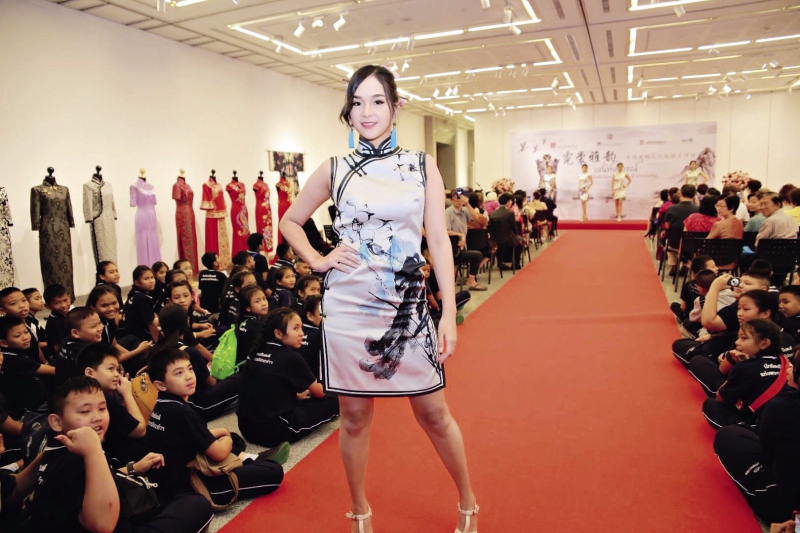
Origin
The cheongsam came into being during the early years of the Qing Dynasty. It evolved from the gowns of the “banner women (qi nü),” which explains why it was called “cheongsam (qipao).”
The original style of cheongsam was relatively simple. It was loose fitting with a round collar and snug-fitting sleeves, suitable for wearing on horseback in the northern prairie of anceint China. After the troops of the Manchu people took over the Central Plains area, which had been occupied by the Han people, and founded their own regime – the Qing Dynasty, their lifestyle began to change, influenced by that of the Han people. The clothing style went though a transformation. Women’s cheongsam then showed more decorative details, such as lace in the neckline, cuffs and the front of the garment.
In the early 1920s, the cheongsam was popularized among both Manchu and Han women, and was known as the national dress of women. After years of development, the design of the cheongsam is now mainly divided into the Beijing style, the Shanghai style and the Hong Kong style.
As the imperial captial, Beijing’s hierarchy influenced the Beijing-style cheongsam. This version was more conservative and traditional. It featured wide edges, heavy decorations, and bright colors. In addition, the material of choice was relatively heavy brocade and the loose design showed off the elegance of the wearer.
The Beijing-style cheongsam was mainly made by hand. Behind the seemingly simple lines, there is a complex production process. For example, the buttons, which represent the cultural essence of cheongsam, sometimes demand days of work to complete. First, the silk used to make the buttons must be brushed four times with paste to get it to harden. Then, the hardened silk will be cut into strips, which are stitched before a copper wire is inserted. Finally, the silk strips will be ironed under high temperature before completion.
Normally, 26 procedures are needed for silk to become eligible strips to make buttons. They are then made into various patterns by skilled artisans.
At the beginning of the 20th century, the style and production process of cheongsam began to follow that of related modern industries. Hi-tech weaving and dyeing techniques were introduced into its fabric production. The whole making process began to combine both manual and mechanized steps. The styles had also undergone great innovations, making the Chinese cheongsam attractive to an international market with its dignified and elegant style.
The Beijing-style cheongsam has a history of hundreds of years. Now, the traditional making techniques of the garment have been listed as a city-level intangible cultural heritage and its secrets are alive and well.
Walking into the fashion studio of its fifth-generation inheritor Zhang Fenglan, the classic beauty of the cheongsam can instantly transport you into a world of charm and sophistication.
In Zhang’s studio, the gradual evolution of cheongsam can be directly seen on several classic examples, such as the long-sleeved full-length cheongsam of the Qing palace, the cheongsam popular in the period of the Republic of China (1911-1949), and the contemporary cheongsam showing the curves of the female body with attached sleeves. Different embroideries and buttons can give the same cheongsam a whole different style.

Zhang Fenglan teaches primary school students in Bangkok how to make cheongsam buttons.
Inheritance
Zhang Fenglan began to learn fashion design at the age of 15. As the fifth-generation inheritor of the Beijing-style cheongsam-making techniques, she has been dedicated to passing on the inheritance of the craft for years.
The traditional making process of Beijing-style cheongsam covers three main steps: measuring the figure, designing and sewing the cheongsam, and button making. The traditional cheongsam is made from brocade and silk. The traditional manual steps of this handicraft have been preserved from the Qing Dynasty to today.
To Zhang, the three steps all require sophisticated basic skills.
The first step of making cheongsam is measuring the body of a customer. Sometimes, in order to be custom-tailored, a white tailor’s dummy in the same body shape as the customer will be made for sewing purposes and then trying on the cheongsam. After measuring the lady’s body, Zhang does all the sewing work herself. More than 100 colorful bobbins on the wall show the amount of thread variety needed to meet all requirements. To make the buttons, Zhang has a square table in her studio. It is never easy to make a small delicate button. The prepared silk strips need to be carefully wound into a fancy ring, and then thin cotton strips are stuffed inside the silk strips before finally sewing them.
Beside her worktable, there are a range of sewing tools she uses, such as a powder bag, pulp knife, pressing iron and electric sewing machine. In her daily life, in order to get inspiration, Zhang enjoys taking photos of things she is interested in with her smart phone, and later drawing the images on paper and adding her own touches to the drawings for later use.
To Zhang, wearing a cheongsam can give each age group a unique beauty. The vitality and confidence of 20, the maturity of 30, the charm of 40, the elegance of 50 and the calmness of 60 can all be expressed in the design of the garment.
What Zhang and her students pursue is to integrate modern elements and Chinese culture into the making of cheongsams, expand its cultural connotations, and make the classic beauty of the cheongsam in line with contemporary fashion.

On the stage of the China Culture Center in Bangkok in September 2018, accompanied by melodious Chinese folk music, a Thai model wearing a Chinese cheong-sam designed and made by Zhang Fenglan walks down the ramp.
Innovation
On weekdays, Zhang works at Huangzhuang Vocational High School in Beijing. On the campus, there is a Beijing cheongsam studio full of colorful cheongsams and various cultural and creative products with cheongsam designs, where Zhang teaches her students, passing on the skills of making qipao. In 2012, the school was listed as an intangible cultural heritage inheritance and education base.
The teaching studio is filled with the ambiance of creative energy. Among the neatly arranged sewing machines, worktables and stools, students focus on their handiwork. In order to facilitate teaching, Zhang has made mini cheongsam samples, using the same craft techniques used on the regular sized garments.
For Zhang, innovation is important and she is constantly pushing the boundaries of her designs. For example, she recreated the costumes of maids and concubines in the hit Chinese costume drama Story of Yanxi Palace, injecting her own ideas. She has not only improved the design of the cheongsam’s front and side slits to make it more in line with women’s taste of today, but has also developed a series of cultural derivative products based on cheongsam buttons.
In 2015, Zhang started to design cultural derivatives of cheongsam: purses, namecard cases, bookmarks, and earrings. She favors heart-shaped designs and tries to add them to the buttons, which are then made into earrings. These products immediately attracted the attention of a wide audience. In 2017, her Chinese-style handbags were also a big hit. They borrowed elements from cheongsam, such as the stand-up collars, buttons, and rims, and added the interlocked design to guard against theft. On the outside, the patterns of dragons and the colors of gold and black add a strong Chinese flavor.
Today, some of these works of art have been officially listed as gift items for foreign affairs activities of Beijing, or even gifts of state to other countries, displaying the colorful intangible cultural heritage of China.
A lot of materials used in daily life have also been incorporated into her designs. Recently her school held an activity to encourage students to make paper cuts of snowflakes for the 2022 Beijing Winter Olympics. This gave Zhang the idea of combining snowflakes with the elements of cheongsam, and she later designed a popular series of gifts using this idea.
Under Zhang’s influence, her students have also developed a serious and rigorous spirit toward their work. Be it cutting fabric, making a small button, or making a small derivative from leftover materials, they are scrupulous in each step. With the participation of more and more young apprentices, the Beijing-style cheongsam has become more widely known to people in China and is in safe hands for years to come.